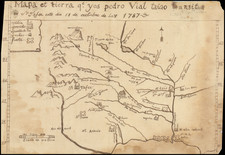Search
Pedro Vial, or Pierre Vial is a fascinating early figure in the history of the exploration and mapping of the Great Plains.
Living extensively among the Comanche and Wichita Indians, including the Taovaya tribe, Vial gained unique insights into their languages and cultures. His skills as a gunsmith and his fluency in French, Wichita, and Spanish enabled him to serve effectively as a peacemaker, guide, and interpreter for the Spanish government, fostering connections between the Spanish and French territories in Texas, New Mexico, Missouri, and Louisiana.
Vial's known history began in 1779, following his visits to Natchitoches and New Orleans, Louisiana, where Spanish authorities noted his residency among "savage nations." His initial engagements with the Taovaya on the Red River at Spanish Fort, Texas, and in Jefferson County, Oklahoma, marked the start of his deep involvement with Native American communities. By Autumn 1784, Vial was in San Antonio, Texas, working to improve relations between the Wichita and the Spanish. His subsequent peace mission with Francisco Xavier Chaves—a Spaniard with a unique upbringing among the Wichita and Comanche—to the Comanche in 1785 led to a peace agreement that significantly impacted Spanish-Native American relations for decades.
In 1786, Vial embarked on a pioneering journey from San Antonio to Santa Fe, New Mexico, marking the first recorded European traversal of the Great Plains along this route. This expedition, which saw him issuing warnings to the Taovaya and wintering among the Comanche, laid the groundwork for future travel and trade routes. His travels did not stop there; Vial continued to forge paths between significant locations, including a journey from Santa Fe to Natchitoches in 1788, and another from Santa Fe to St. Louis in 1792, encountering Francisco Xavier Chavés and various Native American tribes along the way.
Vial's later years were marked by continued service and exploration, even as he faced suspicion and arrest by Spanish authorities in 1795. His attempts to intercept the Lewis and Clark Expedition in the early 1800s on behalf of Spain showcased his enduring commitment to his roles as an explorer and diplomat. Despite facing challenges, including attacks by unidentified Native American tribes in 1805 and the eventual abandonment of a large expedition in 1806, Vial remained a pivotal figure in the Spanish frontier.
Upon the U.S. acquisition of the Louisiana Purchase, Vial adapted to the changing political landscape, receiving a trapping license from Meriwether Lewis in 1808 and continuing his work as an interpreter and guide. His final days were spent in Santa Fe, where he passed away in October 1814.

